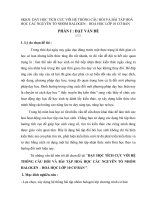Bài tập Hoá vô cơ: cân bằng hoá học
Bạn đang xem bản rút gọn của tài liệu. Xem và tải ngay bản đầy đủ của tài liệu tại đây (466.19 KB, 3 trang )
Chapter 13: Chemical Equilibrium (CHEM 2B)
13.1 A chemical engineer injects limestone (CaCO3) into the hot flue gas of a coalburning power plant to form lime (CaO), which scrubs SO2 from the gas and forms
gypsum (CaSO4.2H2O). Find Kc for the following reaction, if CO2 pressure is in
atmospheres:
13.2 For the reaction N2O4(g) <---> 2NO2(g), Kc = 0.21 at 100°C. At a point
during the reaction, [N2O4] = 0. 1 2 M and [NO2} = 0 If not, in which direction is
it progressing?
13.3 In a study of the conversion of methane to other fuels, a chemical engineer
mixes gaseous CH4 and H2O in a 0.32-L flask at 1200 K. At equilibrium, the flask
contains 0.26 mol of CO, 0.091 mol of H2, and 0.041 mol of CH4. What is [H2O]
at equilibrium? Kc = 0.26 for the equation
CH4(g) + H2O (g) < --- > CO(g) + 3H2(g)
13.4 Fuel engineers use the extent of the change from CO and H2O to CO2 and H2
to regulate the proportions of synthetic fuel mixtures. If 0.250 mol of CO and
0.250 mol of H2O are placed in a 125 -mL flask at 900 K, what is the composition
of the equilibrium mixture? At this temperature, Kc is 1.56 for the equation:
CO(g) + H2O (g) < --- > CO2(g) + H2(g)
13.5 Phosgene is a potent chemical warfare agent that is now outlawed by
international agreement. It decomposes by the reaction
Calculate [CO], [CI2], and [COCI2] when each of the following amounts of
phosgene decomposes and reaches equilibrium in a 1O.0-L flask:
(a) 5.00 mol of COCl2 (b) 0. 100 mol of COCl2
Nguyen Tien Thao, Faculty of Chemistry, Hanoi College of Science, VNU
19 - Le Thanh Tong, Hoan Kiem, Hanoi, Vietnam. Email:
1
13.6 The research and development unit of a chemical company is studying the
reaction of CH4 and H2S, two components of natural gas:
CH4(g) + 2H2S(g) < --- > CS2(g) + 4H2(g)
2.00 mol of H2S, and
In one experiment, 1.00 mol of CH4, 1.00 mol of CS2,
2.00 mol of H2 are mixed in a 250-mL vessel at 960°C. At this temperature, Kc =
0.036.
(a) In which direction will the reaction proceed to reach equilibrium?
(b) If [CH4] =5.56 M at equilibrium, what are the equilibrium concentrations of the
other substances?
13.7 To improve air quality and obtain an useful product, chemists often remove
sulfur from coal and natural gas by treating the fuel contaminant hydrogen sulfide
with O2:
2H2S(g) + O2 (g) < --- > 2S(g) + 2H2O(g)
What happens to
(a) [H2O] if O2 is added?
(b) [H2S] if O2 is added?
(c) [O2] if H2S is removed?
(d) [H2S] if sulfur is added?
12.8 How would you change the volume of each of the following reactions to
increase the yield of the products?
12.9 How does an increase in temperature affect the equilibrium concentration of
the underlined substance and Kc for each of the following reactions?
13.10 For the reaction of nitrogen with hydrogen to produce ammonia:
N2(g) + 3H2 (g) < --- > 2NH3(g)
Nguyen Tien Thao, Faculty of Chemistry, Hanoi College of Science, VNU
19 - Le Thanh Tong, Hoan Kiem, Hanoi, Vietnam. Email:
2
the equilibrium concentrations of N2, H2, and NH3 are 0.15, 0.80, and 0.20 mol/L
respectively at 400°C. What is the value of Kc?
13.11 For the same reaction in Problem 13.10 but at a different temperature, if
one starts with 0.1 8 mol/L of both hydrogen and nitrogen, the equilibrium
concentration of ammonia is 0.040 mol/L. Calculate Kc·
10.12 When gasoline burns in an automobile, the temperature is high enough that
nitric oxide forms from the elements nitrogen and oxygen :
N2(g) + O2 (g) < --- > 2NO(g)
At 2000°C, Kc for this reaction is 0.10. What are the equilibrium concentrations of
NO, N2 and O2, when the starting concentration of each reactant is 1.0 mol/l?
13.13 At a certain temperature, Kc for the reaction (in Problem13.12) between N2
and O2 to form NO is 3.2 x1 0-4. What is the equilibrium concentration of NO
when 0.150 moles of N2 and 0.30 moles of O2 are added to a 1.50 l container?
13.14 For the Haber process in which nitrogen is converted to ammonia
N2(g) + 3H2 (g) < --- > 2NH3(g)
H = -92.0 kJ. If thee quilibrium constant at room temperature is 5.0 x108. At
200°C, will K2 be smaller or larger than K1 ?
Additional problems:
Chapter 13: 19, 21, 23, 33, 37, 41, 47, 49, 51,53, 57, 59, 65, 67, 69
Deadline: 08/22/2011
Nguyen Tien Thao, Faculty of Chemistry, Hanoi College of Science, VNU
19 - Le Thanh Tong, Hoan Kiem, Hanoi, Vietnam. Email:
3









